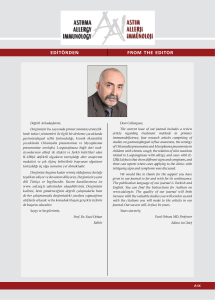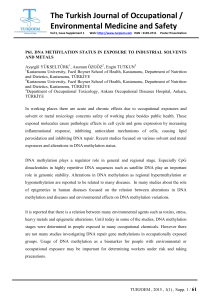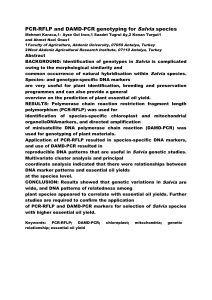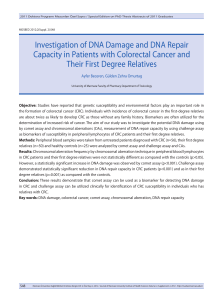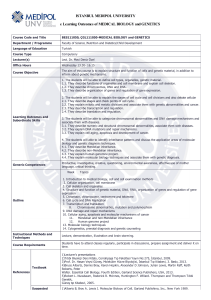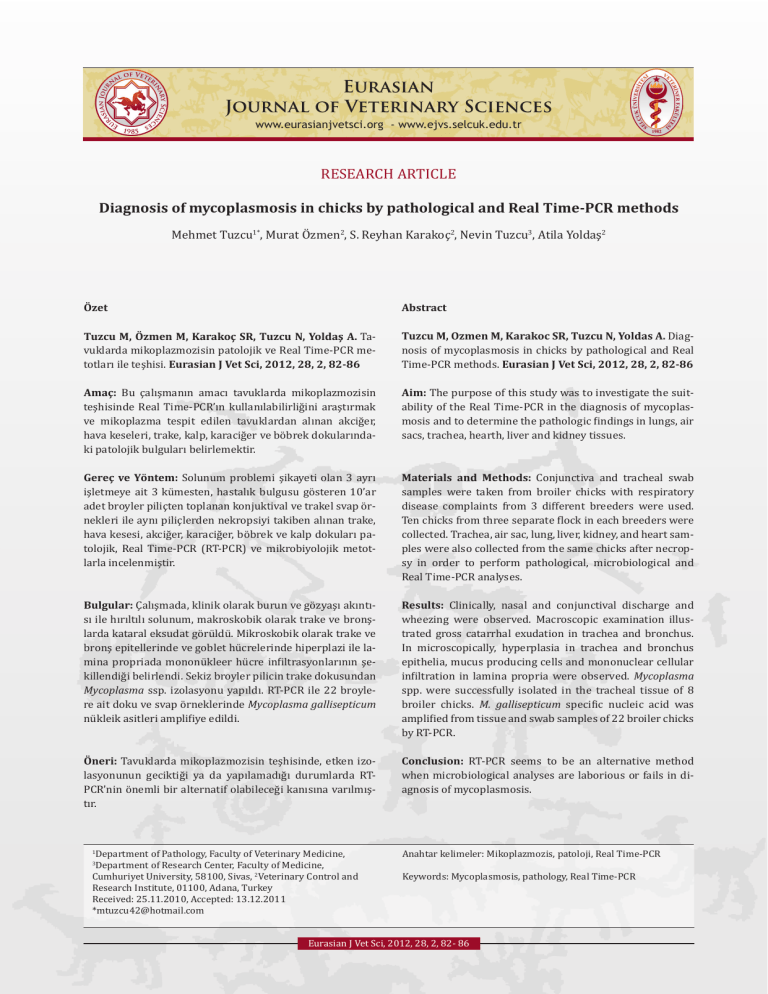
Eurasian
Journal of Veterinary Sciences
www.eurasianjvetsci.org - www.ejvs.selcuk.edu.tr
RESEARCH ARTICLE
Diagnosis of mycoplasmosis in chicks by pathological and Real Time-PCR methods
Mehmet Tuzcu1*, Murat Özmen2, S. Reyhan Karakoç2, Nevin Tuzcu3, Atila Yoldaş2
Özet
Abstract
Tuzcu M, Özmen M, Karakoç SR, Tuzcu N, Yoldaş A. Tavuklarda mikoplazmozisin patolojik ve Real Time-PCR metotları ile teşhisi. Eurasian J Vet Sci, 2012, 28, 2, 82-86
Tuzcu M, Ozmen M, Karakoc SR, Tuzcu N, Yoldas A. Diagnosis of mycoplasmosis in chicks by pathological and Real
Time-PCR methods. Eurasian J Vet Sci, 2012, 28, 2, 82-86
Gereç ve Yöntem: Solunum problemi şikayeti olan 3 ayrı
işletmeye ait 3 kümesten, hastalık bulgusu gösteren 10’ar
adet broyler piliçten toplanan konjuktival ve trakel svap örnekleri ile aynı piliçlerden nekropsiyi takiben alınan trake,
hava kesesi, akciğer, karaciğer, böbrek ve kalp dokuları patolojik, Real Time-PCR (RT-PCR) ve mikrobiyolojik metotlarla incelenmiştir.
Materials and Methods: Conjunctiva and tracheal swab
samples were taken from broiler chicks with respiratory
disease complaints from 3 different breeders were used.
Ten chicks from three separate flock in each breeders were
collected. Trachea, air sac, lung, liver, kidney, and heart samples were also collected from the same chicks after necropsy in order to perform pathological, microbiological and
Real Time-PCR analyses.
Amaç: Bu çalışmanın amacı tavuklarda mikoplazmozisin
teşhisinde Real Time-PCR’ın kullanılabilirliğini araştırmak
ve mikoplazma tespit edilen tavuklardan alınan akciğer,
hava keseleri, trake, kalp, karaciğer ve böbrek dokularındaki patolojik bulguları belirlemektir.
Bulgular: Çalışmada, klinik olarak burun ve gözyaşı akıntısı ile hırıltılı solunum, makroskobik olarak trake ve bronşlarda kataral eksudat görüldü. Mikroskobik olarak trake ve
bronş epitellerinde ve goblet hücrelerinde hiperplazi ile lamina propriada mononükleer hücre infiltrasyonlarının şekillendiği belirlendi. Sekiz broyler pilicin trake dokusundan
Mycoplasma ssp. izolasyonu yapıldı. RT-PCR ile 22 broylere ait doku ve svap örneklerinde Mycoplasma gallisepticum
nükleik asitleri amplifiye edildi.
Öneri: Tavuklarda mikoplazmozisin teşhisinde, etken izolasyonunun geciktiği ya da yapılamadığı durumlarda RTPCR’nin önemli bir alternatif olabileceği kanısına varılmıştır.
Department of Pathology, Faculty of Veterinary Medicine,
Department of Research Center, Faculty of Medicine,
Cumhuriyet University, 58100, Sivas, 2Veterinary Control and
Research Institute, 01100, Adana, Turkey
Received: 25.11.2010, Accepted: 13.12.2011
*[email protected]
1
3
Aim: The purpose of this study was to investigate the suitability of the Real Time-PCR in the diagnosis of mycoplasmosis and to determine the pathologic findings in lungs, air
sacs, trachea, hearth, liver and kidney tissues.
Results: Clinically, nasal and conjunctival discharge and
wheezing were observed. Macroscopic examination illustrated gross catarrhal exudation in trachea and bronchus.
In microscopically, hyperplasia in trachea and bronchus
epithelia, mucus producing cells and mononuclear cellular
infiltration in lamina propria were observed. Mycoplasma
spp. were successfully isolated in the tracheal tissue of 8
broiler chicks. M. gallisepticum specific nucleic acid was
amplified from tissue and swab samples of 22 broiler chicks
by RT-PCR.
Conclusion: RT-PCR seems to be an alternative method
when microbiological analyses are laborious or fails in diagnosis of mycoplasmosis.
Anahtar kelimeler: Mikoplazmozis, patoloji, Real Time-PCR
Keywords: Mycoplasmosis, pathology, Real Time-PCR
Eurasian J Vet Sci, 2012, 28, 2, 82- 86
Mycoplasmosis in chicks
83
Introduction
M. gallisepticum infection causes serious problems
all over the world (Zanella 2007). The symptoms of
mycoplasmosis are nasal and conjunctival discharge,
wheezing and coughing. Clinical findings in broilers
are more severe than that of layer chicken. If environmental conditions and coop hygiene are bad and
secondary infections are also noted, mortality rate in
diseased flocks get really higher (Ley 2003, Zanella
2007).
The catarrhal exudates in trachea and sinus bronchus
are known as the defining macroscopic finding during
the necropsy of M. gallisepticum infection in chicks.
Besides, caseous substance in air sacs and fibrin bulks
in liver and hearth are stated in the mycoplasmosis.
Epithelial hyperplasia, increase in number of the cells
that secrete mucus and macrophage in lamina propria
and also lymphocyte and mononuclear cell infiltrations are detected. In lamina propria and submucosa,
lymphoid follicle formations are observed microscopically and fibrin exudation in air sacs and heterophile,
lymphocyte and macrophage cell infiltrations and
degeneration and hyperplasia in epithelial cells are
observed (Rodriguez and Kleven 1980, Levisohn et al
1986, Nunoya et al 1987, Gaunson et al 2000).
Bacteriological isolation methods and serologic tests
(RSA, HI and ELISA) are mostly used in the diagnosis of M. gallisepticum infection (Levisohn and Kleven
2000). With the advent in molecular technology, different Polymerase Chain Reaction (PCR) techniques
can also be used in diagnosis of mycoplasmosis
(Nescimento et al 1991, Garcia et al 2005, Callison et
al 2006, Grodio et al 2008). Previous research reported that primer pairs derived from genes encoding 16S
rRNA and bacterial surface proteins can also be used
in the molecular diagnosis of M. gallisepticum infection (Papazisi et al 2002, Garcia et al 2005).
Garcia et al (2005) used 4 different primer pairs and
showed that mgc 2, LP and gapA primers amplified
only M. gallisepticum DNA. However, 16S rRNA primers amplified both M. gallisepticum and Mycoplasma
imitans in trachea and bronchus. Mekkes and Feberwee (2005) used 16S rRNA primers in RT-PCR analysis in trachea swabs and determined the M. gallisepticum quantitatively as low as 10 CFU/ml. Garcia et
al (2005) also reported that bacteria identification
limit in RT-PCR is lower than classical PCR and culture methods. Çarlı and İyigör (2003) were able to
diagnose the M. gallisepticum infection in chick’s
tracheal swabs by using mga-0319 lipoprotein primers in RT-PCR analysis. In this study (Çarlı and İyigör
2003), the identification limits of the agent was as
low as 3 CFU/ml for pure M. gallisepticum culture and
3000 CFU/mL for contaminated samples. Grodio et al
(2008) quantitatively detected M. gallisepticum using
mgc 2 primers and Taqman probe in conjunctivas of
the hens which were infected beforehand. These re-
Tuzcu et al
searchers stated that the identification power of mgc
2 primers was less than 14 copies of M. gallisepticum
per reaction for plasmid DNA standards and less than
10 copies for genomic DNA standards.
The purpose of this study was to determine M. gallisepticum by RT-PCR and to evaluate pathologic findings in lungs, air sacs, trachea, hearth, liver and kidney of chicks with mycoplasmosis.
Materials and Methods
The chicks were supplied from 3 different breeders’
flocks and ten chicks from each flock were used in the
study. Conjunctival and tracheal swab samples and
tissue samples from trachea, air sac, lung, liver, kidney and hearth were collected from chicks. Half of the
collected tissues were kept for RT-PCR and microbiological examinations and the other halves were transferred to 10% buffered formalin solution for pathological examinations.
Pathological examination
Fixed tissues in 10% buffered formalin solution were
routinely processed and embedded in paraffin blocks.
These blocks were sectioned at 5 μm thickness and
stained with hematoxyline and eosine (H-E). The
stained sections were investigated using a light microscope.
Bacteriological examination
The method of Türkaslan and Salihoğlu (1998) was
used for Mycoplasma spp. isolation and identification. Each tissue samples were homogenized in 1 mL
liquid medium by MagNA Lyser (Roche Diagnostics,
Germany). Tissue samples were inoculated by 1/10 of
Freys medium broth and incubated for 72 hours in 37
0
C. Color changes were observed during the incubation. One mL of sample was taken from the broths in
which turbidity was detected and passages are made
to Freys medium agar and Freys medium broth. These
passages were examined by stereo microscope (Magnüs Analitics, India) for 10 days, and colonies that
looked like fried egg were accepted as positive findings of Mycoplasma spp.
DNA isolations from swab samples
High Pure PCR Template DNA Extraction Kit (Roche,
Germany, Katolog #11796828001) was used for DNA
isolation. Swab samples are vortexed by soaking into
1-2 mL sterilized physiological salt water. One mL of
supernatant was taken for DNA isolations and then
380 μL Bacteria Lysis Buffer and 20 μL proteinase-K
were added. After incubation at 65 0C for 10 min and
95 0C for 10 min, 100 μL isopropanol was added to the
suspension and mixed. The suspension was put in filtered tubes and centrifuged for 1 minute at 8000 rpm
and supernatant was removed. The suspension was
put in clear collection tube and 500 μL Wash Buffer
Inhibitor was added and the suspension was centrifuged for 1 minute at 8000 rpm. Then the suspension
Eurasian J Vet Sci, 2012, 28, 2, 82- 86
Mycoplasmosis in chicks
was transferred in clear collection tube and treated
twice with 500 μL Wash Buffer was addition and following centrifugation at 8000 rpm for 1 min. In the
last step, filter tubes were placed in an eppendorf
tube and DNA was eluted by adding 100 μL preheated
elution buffer (70 0C) and was centrifuged for one
minute 8000 rpm. The isolated DNA’s were kept at -20
0
C until PCR analysis.
DNA isolations from tissue samples
High Pure PCR Template DNA Extraction Kit (Roche,
Germany) was also used for DNA extraction from tissue samples. About 5 mg of tissue samples were taken
and 200 μL of Tissue Lysis Buffer and 40 μL proteinase-K were added. Having incubated for 1 hour at 55
0
C, 100 μL isopropanol was added to the suspension
and mixed. The suspension was put in filtered tubes
and centrifuged for 1 min at 8000 rpm and supernatant was removed. The suspension was put in clear
collection tube and 500 μL Inhibitor Removal Buffer
was added and the suspension was centrifuged for
1 min at 8000 rpm. Then the suspension was transferred in a clear collection tube and treated twice with
500 μL Inhibitor Removal Buffer and DNA was eluted
from columns as described above. DNA was quantified 260 and 280 nm UV using spectrophotometer
(NanoDrop ND-2000, Germany).
Real Time PCR Analyses
Grodio et al (2008)’s method was used by same
minor modifications. In RT-PCR analysis, Light Cycler Taqman Master Kit (Roche, Germany, Katalog #
04535286001) was used. In amplification, mgc2-F
(5’-GGTCCTAATCCCCAACAAAGAAT-3’) and mgc2-R
(5’-CTTGGTTGGTTCATATTAGGCATTT-3’)
primers
and Taqman probe (5’-6-FAM-CCACAGGGCTTTGGT-
84
Tuzcu et al
GGCCCA-TAMRA) were used. These primers were previously reported (Garcia et al 2005) and specifically
developed from a repeated region of M. gallisepticum
genome.
RT-PCR protocol was 95 0C for 10 min and 45 cycles
of 95 0C 30 sec, 60 0C’ 30 sec and 72 0C 1 min using a
Roche Light Cycler 2.0. In all steps of RT-PCR analysis,
DNA of M. gallisepticum S6 strain was used as positive
control which was supplied from Pendik Veterinary
Control and Research Institute, Mycoplasma Laboratory and distilled water was used as negative control.
Standard curve
Based on Macfarland method, genomic DNA isolated
from 3x108 CFU/mL M. gallisepticum S6 and decimally diluted to make up standard curve of copy numbers
from 3x100 to 3x108. The productivity of M. gallisepticum genomic DNA standard curve between the works
was calculated from the mean CP values triplicates.
Results
Pathological findings and their ratios were given in
Table 1. Nasal and conjunctiva discharge, coughing
and wheezing were among the clinical findings of the
chicks examined in this study. The most significant
necropsy finding was yellow-gray colored exudates
found in trachea and bronches. Goblet and epithelial hyperplasia and mononuclear cellular infiltration
composed of macrophages, lymphocytes and plasma
cells were detected in the lamina propria of trachea
and bronchia (Figure 1A-1B). In the mucosa of air
sacs heterophyl, lymphocyte and macrophage infiltrations were seen. Also degeneration and necrosis were
present in the epithelia.
Table 1. Pathological findings obtained in the study and their observation rates.
Macroscopic Findings
Mucous lacrima flow
1th Coop
2nd Coop
3rd Coop
4/10
5/10
3/10
5/10
Mucous flow in nose
Catarrhal exudate in trachea
5/10
Pneumonic areas in lungs
4/10
Catarrhal exudate in air sacs
2/10
Fibrine in pericard
1/10
5/10
7/10
6/10
3/10
-
3/10
6/10
6/10
1/10
-
Fibrine in liver
1/10
-
1/10
Goblet cells hyperplasia in trachea
5/10
7/10
6/10
Microscopic Findings
Macrophage lymphocyte and plasma cell infiltrations in lamina propria of trachea
Hyperplasia in epithelium of bronches
Peribronchiolar macrophage, lymphocyte and plasma cell infiltrations
Desquamation and necrosis in epithelia of air sacs
Pericarditis fibrinosa
Perihepatitis fibrinosa
5/10
5/10
3/10
1/10
1/10
Microbiologic Findings
RT-PCR Findings
4/10
2/10
Eurasian J Vet Sci, 2012, 28, 2, 82- 86
8/10
6/10
7/10
7/10
3/10
-
1/10
2/10
6/10
6/10
6/10
6/10
1/10
-
1/10
4/10
8/10
Mycoplasmosis in chicks
85
Figure 1. Hyperplasia in goblet cells, in trachea (thick arrows) and
mononuclear cell infiltrations (thin arrows), H-E, x 260 (A), Peribronchiolar, infiltration of plasma cell and lymphocyte, H-E, x 260 (B).
Mycoplasma spp. were successfully isolated in only
tracheal tissues of 8 broiler chicks. In two cases (20%)
in the first and second flocks and 4 cases (40%) in the
third lock, Mycoplasma spp. were isolated. M. gallisepticum DNA was detected from samples of 8 broilers (80%) from the first and third flocks and 6 chicks
from the second flocks by RT-PCR. The ratios of the
microbiological and RT-PCR methods were given in
Table 1. Copy-numbers of M. gallisepticum genomic
DNA and representative mean CP values in tissue and
swap samples chicks that were M. gallisepticum positive were given in Table 2.
Table 2. M. gallisepticum genomic DNA copies and their crossing
points (CP).
M. gallisepticum Genomic DNA copies
Copy/mL
Trachea
5.99±3.73x105
Air Sacs
8.19±1.20x102
Lung
6.50±2.17x102
Liver
Hearth
Kidney
Trachea (Swab)
5.83±2.73x104
Conjunctiva (Swab) 3.86±1.07x104
Log 10
4.76
2.62
2.44
3.90
3.58
CP Values
25.44
32.84
33.74
28.74
31.22
Discussion
We have detected pathological findings of catarrhal
exudates in bronchus and trachea, thickening of air
sacs mucosa of chicks. Degenerations and necrosis
of air sacs and hyperplasia of epithelia of trachea
and bronchus, goblet cells were seen. Mononuclear
cell infiltrations were also determined in the lamina
propria of these organs. These findings were previously were reported in M. gallisepticum infection in
chicks (Nunoya et al 1987, Levisohn and Kleven 2000,
Gaunson et al 2000). However; similar pathological
findings can also be observed in other diseases such
as haemophilus infection, infectious bronchitis and
infectious laryngotracheitis (Ley 2003, Zanella 2007).
Other than this possibility which hampers pathological diagnosis of the disease might be difficult if M. gallisepticum infection is complicated by secondary factors like Escherichia coli (Ley 2003).
Tuzcu et al
The high detection rate of pathological findings in trachea, lung, air sacs comparing with other organs corresponds to the high diagnosis ratio of nucleic acids
quantitatively in tissue and swap samples of trachea,
lung and air sacs and by real time PCR. Since primary
target organs of the disease are respiratory system
organs, pathologic lesions’ severity will be proportional with the number of bacteria. Again in this study,
macroscopic and microscopic lesions were observed
in three and four cases respectively. However, no M.
gallisepticum DNA was detected in heart and liver
samples by RT-PCR, which suggested that the lesion
in these organs possibly caused by secondary factors.
Since the pathological findings are not solely enough
for diagnosis of mycoplasmosis, in most of the cases
pathologic diagnosis must be supported by microbiological methods. However the microbiological methods require a long period of time, and sometimes can
be difficult due to use of antibiotics and the requirement of certain amount of bacteria in the material.
Although positive results can generally be obtained in
4-7 days, 30 days are needed to make a descriptive
diagnosis. However, this time table is rather a long
period of time for poultry breeding (Türkaslan and
Salihoğlu 1989, Özdemir and Erer 2008).
Different PCR protocols were reported for diagnosis
of M. gallisepticum infection (Çarlı and Eyigör 2003,
Garcia et al 2005, Callison et al 2006). PCR can be an
alternative for microbiological, pathological and serological diagnosis methods (Levisohn and Kleven
2000, Garcia et al 2005, Mekkes and Feberwee 2005,
Grodio et al 2008). However, PCR and especially RTPCR based techniques require a good deal of groundwork for devices and expensive consumable materials
contrary to other methods. As well as providing reliable diagnosis in a short time, the advantage of molecular methods based on PCR is to diagnosis of disease
in flocks which treated with antibiotics beforehand
(Çarlı and Eyigör 2003). Because, PCR based techniques can amplify both DNAs of alive and death M.
gallisepticum. In this study, nucleic acids belongs to
M. gallisepticum were detected in 22 of the chickens
by RT-PCR. The fact that in all of the cases in which
M. gallisepticum infection was identified, bacterial nucleic acids were remarkably amplified in tissue and
swap samples of trachea. Accordingly, we were able
to isolate and identify the agent in samples taken only
from the trachea suggests that there must be a large
number of agents present in these organs. Moreover,
it can increase the rate of success in the agent isolation of the swabs taken from trachea and conjunctiva
during microbiological examinations.
Conclusions
The sensitivity of RT-PCR and pathologic methods
were compared in the diagnosis of mycoplasmosis in
chicken. It was shown that RT-PCR can be possible in
the diagnosis of mycoplasmosis in chicken when the
agent cannot be isolated by microbiologic mean.
Eurasian J Vet Sci, 2012, 28, 2, 82- 86
Mycoplasmosis in chicks
86
References
Callison SA, Riblet SM, Sun S, Ikuta N, Hilt D, Leiting V, Kleven SH, Suarez DL, Garcia M, 2006. Development and validation of a real-time Taqman polymerase chain reaction
assay for the detection of M. gallisepticum in naturally
infected birds. Avian Dis, 50, 537-544.
Çarlı KT, Eyigör A, 2003. Real-time polymerase chain reaction for detection of M. gallisepticum in chicken trachea.
Avian Dis, 47, 712-717.
Garcia M, Ikuta N, Levisohn S, Kleven SH, 2005. Evaluation
and comparison of various PCR methods for detection
of M. gallisepticum infection in chickens. Avian Dis, 49,
125-132.
Gaunson JE, Philip C J, Whithear KG, Browning GF, 2000.
Lymphocytic infiltration in the chicken trachea in response to M. gallisepticum infection. Microbiology, 146,
1223-1229.
Grodio JL, Priscilla HD, Schat KA, 2008. Detection and quantification of M. gallisepticum genome load experimentally infected house finches (Copradacus mexicanus) using real-time polymerase chain reaction. Avian Pathol,
37, 385-391.
Levisohn S, Kleven SH, 2000. Avian mycoplasmosis (Mycoplasma gallisepticum). Rev Sci Tech, 19, 425-442.
Levisohn S, Dykstra MJ, Lin MY, Kleven SH, 1986. Comparison of in vivo and in vitro methods for pathogenicity
evaluation for Mycoplasma gallisepticum in respiratory
infection. Avian Pathol, 15, 233-246.
Tuzcu et al
Ley DH, 2003. Mycoplasma gallisepticum infection, In: Diseases of Poultry, Eds; Calnek BE, Barnes HJ, Beard CW,
McDougald LR, Saif YM, 11th edition, Ames, Iowa, Iowa
State University Press, USA, pp: 194-207
Mekkes DR, Feberwee A, 2005. Real-time polymerase chain
reaction for the qualitative and quantitative detection of
Mycoplasma gallisepticum. Avian Pathol, 34, 348-354.
Nascimento ER, Yamamoto R, Herrick RK, Tait RC, 1991.
Polymerase chain reaction for detection of Mycoplasma
gallisepticum. Avian Dis, 35, 62-69.
Nunoya T, Tajima M, Yagihashi T, Sannai S, 1987. Evaluation
of respiratory lesions in chikens induced by M. gallisepticum. Jpn J Vet Sci, 49, 621-629.
Özdemir Ö, Erer H, 2008. Pathological and microbiological
investigations on the lesions of the respiratory systems
of laying hens. Eurasian J Vet Sci, 24,2,55-68.
Papazisi L, Frasca SJR, Gladd M, Liao X, Yogev D, Geary SJ,
2002. GapA and CrmA coexpression is essential for
Mycoplasma gallisepticum cytadherence and virulence.
Infect Immun, 70, 6839-6845.
Rodriguez R, Kleven SH, 1980. Pathogenicity of two strains
of Mycoplasma gallisepticum in broilers. Avian Dis, 24,
800-807.
Türkaslan J, Salihoğlu H, 1989. Çeşitli besiyerleri kullanılarak
Mycoplasma gallisepticum’un bakteriyolojik yöntemlerle izolasyon ve identifikasyonu. Pendik Hay Hast Araşt
Enst Derg, 20, 53-59.
Zanella A, 2007. Poultry Disease Manual, FATRO, Italy.
Eurasian J Vet Sci, 2012, 28, 2, 82- 86


